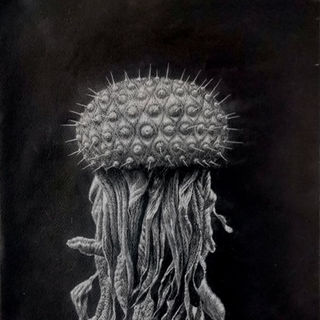LAURA MANINO
Using a pseudoscientific methodology, the artist seeks to discover the territory of which, as an artist, she is a part, by personal choice. Explore, walk and observe. Analyze the areas of accumulation of materials, the frequency of the finds, the influence of the weather or the tide. Collect manually and investigate the origin of the materiality found, with scientific advice. It carries out the collection of these structures on the beaches of Formentera with the authorization of the Ministry of the Environment of the Balearic Government.
In this work, the massive presence on the beaches of the remains of an animal species, belonging to the Porifera class of the Spongiide family, called common marine sponge, is questioned. These remains are a specificity of the territory. What were the conditions that occurred for the arrival of the sponges on the beach? What processes and metamorphoses did they go through? Imagine their history and journey until their fortuitous meeting. In the methodology of his work, he incorporates painting to explore the physical capabilities of the collected skeletons of marine sponges. From the absorption property of the material, observe the changes in texture, volume, weight, and flexibility.
Measure and weigh the marine sponge on a precision scale, before and after immersing it entirely in water pigments.
Record the physical changes produced and then pour the material absorbed by the sponge onto the support. Seek to get as many results as possible. Paint pools, settles, cracks, blends, or blends. traces remain
of the porosity and natural irregularity of the sponges. The experimental result, despite its methodical nature, is strange and accidental. With this working method, he seeks to create a possible emotional understanding of the landscape.

Fabián La Rosa's work is framed within a deep exploration of social structures and cultural identities, using botanical metaphors to articulate a visually symbolic narrative. Self-taught from an early age, La Rosa has developed an artistic approach that amalgamates the aesthetic with the socio-political in a symbiosis that invites reflection.
A resident of San Telmo, his journey has taken him from San Martín de los Andes, where nature and art were his first guides, to the main galleries of Buenos Aires, always maintaining an intrinsic connection with his environment.

BIO
Fabián La rosa vive y trabaja en San Telmo. Autodidacta, inició su vínculo con el dibujo y la pintura a los 5 años. A los 16 se trasladó a San Martín de los Andes, Neuquén, Argentina, donde el contacto con la naturaleza y los libros de arte fueron sus maestros. En 1992 realizó su primera exposición en el Centro Amancay de esa ciudad y pronto comenzó a vivir exclusivamente de su obra. Participó en exposiciones colectivas como el Museo Nacional de Bellas Artes de Neuquén -MNBA, el Premio OSDE y Argentina Pinta Bien -programa coordinado por el Fondo Nacional de las Artes de Argentina-, en el Centro Cultural Recoleta. En 2009 se instaló en Buenos Aires y trabajó con galerías de arte como Maman, Aldo de Sousa, Holz y Zurbarán. En 2016, tras alejarse del circuito galerístico, empezó a dedicarse también a la docencia. En 2021 pasó una residencia personal en la Patagonia y luego retomó su producción en Buenos Aires. Hoy desarrolla una obra donde lo estético convive con lo político-social y lo mágico.
He lives and works in San Telmo, Buenos Aires, Argentina. A self-taught artist, he began his relationship with drawing and painting at the age of 5. At 16, she moved to San Martín de los Andes, Neuquén, Argentina, where his connection with nature and art books became her teachers. In 1992, he held his first exhibition at the Centro Amancay in that city and soon began living exclusively from his art. He participated in group exhibitions at venues such as the Museo Nacional de Bellas Artes de Neuquén (MNBA), the OSDE Prize, and ´Argentina Pinta Bien´—a program coordinated by the National Arts Fund of Argentina—at the Centro Cultural Recoleta. In 2009, he moved to Buenos Aires and worked with art galleries such as Maman, Aldo de Sousa, Holz, and Zurbarán. In 2016, after stepping away from the gallery circuit, he also began teaching. In 2021, he spent a personal residency in Patagonia and then resumed her production in Buenos Aires. Today, he develops work where the aesthetic coexists with the political-social and the magical.







